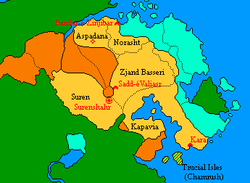Suren Confederacy
| Dowlat-e Aliyye-ye Suren | |||
| |||
| Motto: Marā dād farmūd-o khod dāvar ast | |||
| Anthem: Ey Eura | |||

| |||
| Map versions | N/A | ||
| Capital | Surenshahr | ||
| Largest city | Bandar-é Zinjibar | ||
| Official language(s) | Babkhi | ||
| Official religion(s) | Zurvanism | ||
| Demonym | Suren | ||
| - Adjective | Surenid | ||
| Government | Tribal confederation | ||
| - Surenšāh | Dāryuš of the Suren | ||
| - Grand Vizier | Bānū Aspadanadoḵt, | ||
| - Legislature | Majles-e Suren | ||
| Establishment | TBC | ||
| Area | 2,412,144 km sq | ||
| Population | 7,620,348 subjects | ||
| Currency | Tomān | ||
| Calendar | |||
| Time zone(s) | |||
| Mains electricity | |||
| Driving side | |||
| Track gauge | |||
| National website | |||
| National forum | |||
| National animal | |||
| National food | |||
| National drink | |||
| National tree | |||
| Abbreviation | SUR | ||
Geography
The Zjandarian steppe has an extreme continental climate; most of the country is open plain, with enough rain in the north, from the sub-tropical Norashti coast, for extensive wheat farming, but turning to grasslands and then desert further south. The large-scale irrigation networks built over the span of centuries swiftly fell into ruins following the Babkhan Holocaust of 1598, and irradiated dead zones, together with stretches of glassed desert, still mark the destruction of the old Babkhan kingdom. Tentative efforts at a revival of agriculture have focused upon boring down into the deep continental aquifers to draw up the life-giving waters for new experimental cotton plantations, however this in turn has led to saline soil problems that have rapidly become evident.
The desert winds of the inner Euran hellscape continue to whip up and deposit clouds of radioactive ash which can blanket vast swathes of the country, with deleterious effects on farming and human habitation, necessitating the development of shelters and survival strategies for both.
Salt deposits, where they are clear of contamination, are in and of themselves vital for the prospective revival of the society. The largest concentrations of these, along with such hydrocarbon deposits as have thus far been identified, are to be found in the lands of the Suren Ostan, the south-western limb of the confederacy. Though much of the Suren Ostan is flat desert and semi-desert, the high mountains of the north-west are a major source for the rivers which flow in a south easterly direction towards Lake Erik and the Androphagi megariver. Irrigation networks repaired here yield cotton and the mulberry trees vital for harvesting silkworm while the poor mountain and desert pasturage. Copper, gold, iron, chromium, and other mineral deposits located in the Durranian highland regions hint at the possibility of future prosperity if they can be secured against Constancian competitors.

